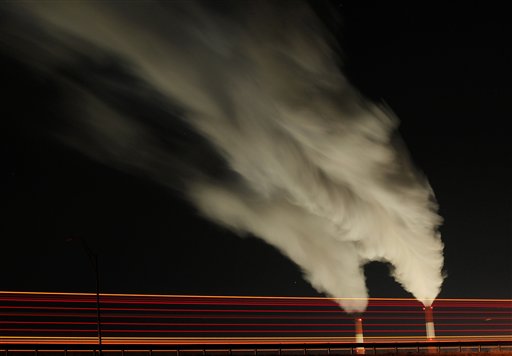Every morning, we look into the mirror to find a reflection of ourselves no different from that of the night before. It is not until months or years later when we come across a picture of ourselves from the past when we notice the unfortunate gaining of weight, the wrinkling of skin, and the graying of hair.
Beyond the scope of our immediate surroundings, there have also been changes to our planet over the years. From the glaciers retreating to the Arctic ice caps melting, from sea levels rising to the extreme weather conditions occurring with increasing frequency – all of these calamities are a bellwether of the Earth’s changing climate and rising temperature.
However, some skeptics point to the end of the ice age and draw parallels between then and now, claiming that the current change in climate is not man-made, but rather a part of Earth’s natural climate cycle. This is a frustrating and dangerously myopic notion that not only disregards the obvious, but also misinforms the public. An ice age takes hundreds of thousand years to come to an end, but the current climate change is noticeable within a person’s lifetime. More importantly, unlike us humans, ice age animals did not use fossil fuels, which emits carbon dioxide into the atmosphere and dangerously amplifies the Greenhouse Effect.
Rather than blaming the government for not being better prepared for unprecedented large-scale natural disasters and dismissing the reemergence of global warming talks by politicians as unnecessarily alarming and tools for political gain, we should recognize that such rare weather phenomena were not localized incidents, but rather, a manifestation of the reality of our changing planet.
When we accept that global warming is manmade, it will become clear that a dilemma caused by man, can be solved by man.
Given our current dependence on coal and gas, a global project to phase out fossil fuel usage may seem like an impossible mission. One such effort, the United Nations treaty Kyoto Protocol, has not yet made substantial contributions to the global crisis. One of the flaws of the treaty is that developing countries such as China and India, that are major contributors of greenhouse gas emissions, are not given strict regulation requirements under the Kyoto Protocol. Instead, the Protocol requires more emission reduction by developed countries and that the developed countries provide financial aid to developing countries to help with reducing emission and to compensate for damages caused by climate change.
For those reasons, the United States has refused to be a member of the Kyoto Protocol ever since its introduction during the Clinton presidency and claims that the treaty is uselessness and particularly harmful to the U.S. economy. The opposition particularly heightened during the Bush Administration, and the Obama Administration also has not shown its support for the U.N. treaty. Despite some domestic measures, such as the Sierra Club’s Beyond Coal campaign to reduce coal use and the increased availability for energy efficient cars, to combat global warming requires cooperation of the international community.
To help facilitate an internationally concerted effort to combat global warming, we can look to the successful example set by another international treaty – the Montreal Protocol on Substances that Deplete the Ozone Layer.
In the 1980s, scientists, prompted by the discovery of the Antarctic ozone hole, recognized the seriousness of the deteriorating condition of the ozone, and found that chlorofluorocarbons (CFCs), predominantly used as propellants in aerosol cans, were the main culprits. The heightened possibility for developing skin cancer and cortical cataracts due to a deteriorating ozone posed as a direct threat to the wellbeing of virtually everyone. In response, every member nation of the U.N. signed the Montreal Protocol and has reduced over 95% of the global CFC emission. Furthermore, American businesses began developing environmentally friendly substitutes for CFC in their products when the public opinion was overwhelmingly supportive of measures to deal with the release of CFC, as a result of the attention the U.S. media paid to the dangers of a deteriorating ozone.
An important lesson to be learned from the Montreal Protocol is that before an effective international agreement can take place, the public needs to recognize the dangers of global warming and be supportive of climate policies. Public consensus will ensure maximum cooperation not only between nations, but also between citizens, businesses, and the government within each country.
But the gradualness of global warming, as opposed to the direct harm that a depleting ozone can have on human health, explains the lack of a sense of urgency and countries’ sluggish and unorganized actions towards regulating carbon dioxide.
What we need is an Uncle Tom’s Cabin of global warming – an effective campaign that will raise awareness of the seriousness of climate change and rally public opinion, putting pressure on the government and manufacturers alike. Like the antebellum novel that awakened the U.S. public to the horrors of slavery, the campaign will aim at appealing people’s emotions by widely publicizing dangerous implications of global warming. The emotional appeals, however, should be backed by facts and thorough research, rather than distorted statistics or misinformation, which would discredit the integrity of the campaign. Originating from the U.S., the campaign will also take advantage of the accessibility and pervasiveness of the Internet in America and fully utilize the social media, a popular forum for information exchange and a powerful tool to influence the public opinion. If successful, its relevance will far outlast the infamous, overnight sensation “Kony 2012” and propel actions within the States. The United States’ being on board with battling climate change will surely set an example to other nations for taking more definitive actions.
Such actions would begin with the implementations of climate policies aimed at reducing carbon dioxide emission and phasing out of the use of fossil fuels; providing incentives, as many economists suggest, would be the most cost-effective way to do so. Cap-and-trade and carbon tax, are the two promising measures.
Under cap-and-trade, a “cap,” or a limit on the amount of carbon dioxide allowed to be emitted in each country, will be set by an international agreement after thorough scientific research. A limited number of emission permits, also termed carbon credits, or the “right to emit,” are allocated to companies by the government of each individual country. When a company cannot reduce enough of its emissions, it can purchase additional emission permits from another company that has excelled in lowering its level of carbon discharge. Therefore, a trading market of carbon credits is created. A firm that has concentrated its efforts on decreasing carbon emission can be rewarded by selling its unused permits. Other companies that are not as successful have to pay extra in order to go over the “cap.” Because no company would want to pay to its competitors, cap-and-trade creates an incentive for businesses to implement energy efficiency measures and switch to alternative energy.
Customers should also have an incentive for reducing their individual carbon footprints. The implementation of a carbon tax on everything from gasoline and electricity to airplane tickets not only sends the message to the public that it is everyone’s responsibility to solve the global crisis, but also motivates consumers to eliminate carbon emission in their everyday lives. For example, increasing the price of gasoline will prompt consumers to consider carpooling, purchasing hybrid or electric cars, or choosing alternative modes of transportation. However, the tax on carbon should also be set to increase gradually to allow time for the public to make adjustments to their lifestyles.
Combining the merits of the two plans, my proposal to reduce carbon emission on a global level will not only target the principle polluters through cap-and-trade, but also impact the general public through the carbon tax. Together both methods would get everyone on board to expedite the reversal of global warming.
We, the inhabitants of Earth, are pulled towards the surface of the Earth due to the Earth’s incredible mass; but the Earth will never, ever be drawn to all five-foot-two and 100 pounds of me. It may seem far-fetched that I should dream to have any impact on our planet. However, mankind has collectively raised the average temperature of the Earth. I believe that, collectively, we also have the ability to reverse what we have done to our planet. All tall flames begin with a spark, and all great journeys start with a tentative first step. The outcome of the measures taken today may not be felt tomorrow, but it is better to start now than to wait until it is too late.










